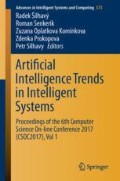Abstract
Stroke is a life-threatening, deadly cause, which occurs due to the interruption of blood flow to any part of brain. As stroke is a globally alarming deadly cause, using computational expertise to aid this problem, is high on demand. In this paper, our proposed system focuses on the potential risk factor for system design. Using computational technique, we prune unnecessary risk factors which are less likely to cause stroke on patient dataset collected from a medical college in Bangladesh. Fuzzy C-means classifier and Fuzzy Inference System are used to classify input data. Later on, to generate fuzzy rule we use Adaptive Neuro-fuzzy Inference System so that it can give better prediction. The developed system provides higher accuracy which satisfies the physicians’ demand. Therefore, the developed system will aid not only general people but also medical experts.
Access this chapter
Tax calculation will be finalised at checkout
Purchases are for personal use only
References
CDC, CDC global health - Bangladesh, CDC (2014). https://www.cdc.gov/globalhealth/countries/bangladesh/. Accessed 7 Jan 2017
Islam, N., et al.: Burden of stroke in Bangladesh. Int. J. Stroke 8(3), 1–3 (2012). https://www.researchgate.net/publication/230847528_Burden_of_stroke_in_Bangladesh. Accessed 7 Jan 2017
Bernstam, E.V., Smith, J.W., Johnson, R.: What is biomedical informatics? J Biomed Inform. 43(1) (2010). https://www.ncbi.nlm.nih.gov/pmc/articles/PMC2814957/. Accessed 7 Jan 2017
Muhic, I.: Fuzzy analysis of breast cancer disease using Fuzzy C-Means and pattern recognition. SE. Eur. J. Soft Comput., 50–55 (2009). http://scjournal.ius.edu.ba/index.php/scjournal/article/viewFile/45/45. Accessed 7 Jan 2017
Sanakal, R., Jayakumari, S.: Prognosis of diabetes using data mining approach-fuzzy C Means clustering and support vector machine. Int. J. Comput. Trends Technol. 11(2), 94–98 (2014)
Rustempasic, I., Can, M.: Diagnosis of Parkinson’s disease using Fuzzy C-Means clustering and pattern recognition. SE. Eur. J. Soft Comput. 2, 42–49 (2013)
Chitra, R.: Heart attack prediction system using Fuzzy C Means classifier. IOSR J. Comput. Eng. 14(2), 23–31 (2013)
Dhanushkodi, S., Sahoo, G., Nallaperumal, S.: Designing an artificial neural network model for the prediction of Thrombo-embolic stroke. Int. J. Biometrics Bioinform. (IJBB), 3(1) (2009). http://www.cscjournals.org/library/manuscriptinfo.php?mc=IJBB-7. Accessed 7 Jan 2017
McIntosh, J., Webberley, H.: Stroke: Causes, symptoms, diagnosis and treatment. Medical News Today (2016). http://www.medicalnewstoday.com/articles/7624.php. Accessed 7 Jan 2017
Witten, I.H.: More Data Mining with Weka
Cluster validation. https://hlab.stanford.edu/brian/cluster_validation.html. Accessed 7 Jan 2017
Cluster analysis, in Wikipedia, Wikimedia Foundation (2017). https://en.wikipedia.org/wiki/Cluster_analysis. Accessed 7 Jan 2017
MathWorks, T.: Data clustering (1994). https://www.mathworks.com/help/fuzzy/data-clustering.html?requestedDomain=www.mathworks.com. Accessed 7 Jan 2017
Adaptive neuro fuzzy inference system, in Wikipedia, Wikimedia Foundation (2016). https://en.wikipedia.org/wiki/Adaptive_neuro_fuzzy_inference_system. Accessed 7 Jan 2017
Acknowledgment
The authors of this project would like to thank North South University, to give an opportunity to work here. We also thank Dhaka Medical College for allowing us to conduct the survey and Dr. Yeasir Arefin Ovi, a practicing Doctor of Dhaka Medical College for supporting us throughout our project. We would like to convey our gratitude to Dr. Kapil Rahman, ICU duty doctor of Holy Family Medical College, Dhaka, Bangladesh for guiding us with his medical knowledge and findings.
Author information
Authors and Affiliations
Corresponding author
Editor information
Editors and Affiliations
Rights and permissions
Copyright information
© 2017 Springer International Publishing AG
About this paper
Cite this paper
Islam, F., Shoilee, S.B.A., Shams, M., Rahman, R.M. (2017). Potential Risk Factor Analysis and Risk Prediction System for Stroke Using Fuzzy Logic. In: Silhavy, R., Senkerik, R., Kominkova Oplatkova, Z., Prokopova, Z., Silhavy, P. (eds) Artificial Intelligence Trends in Intelligent Systems. CSOC 2017. Advances in Intelligent Systems and Computing, vol 573. Springer, Cham. https://doi.org/10.1007/978-3-319-57261-1_26
Download citation
DOI: https://doi.org/10.1007/978-3-319-57261-1_26
Published:
Publisher Name: Springer, Cham
Print ISBN: 978-3-319-57260-4
Online ISBN: 978-3-319-57261-1
eBook Packages: EngineeringEngineering (R0)

